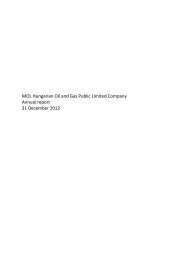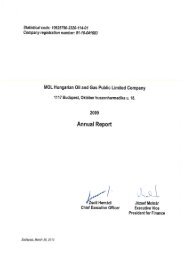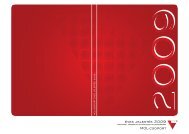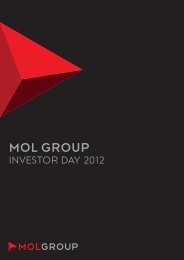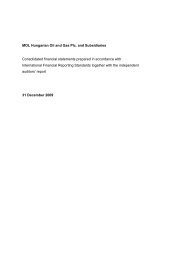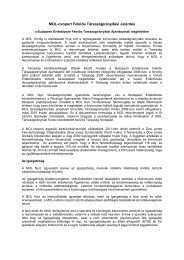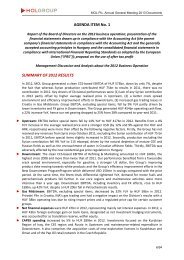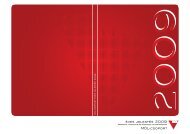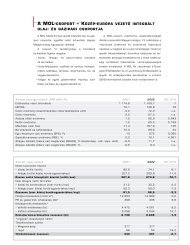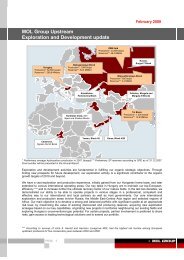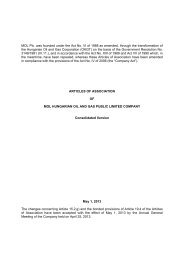Joint venturesA joint venture is a contractual arrangement whereby two or more parties (venturers) undertake an economic activity that issubject to joint control. Joint control exists only when the strategic financial and operating decisions relating to the activityrequire the unanimous consent of the venturers. A jointly controlled entity is a joint venture that involves the establishment ofa company, partnership or other entity to engage in economic activity that the Group jointly controls with its fellow venturers.The Company’s interests in its joint ventures are accounted for by the proportionate consolidation method, where aproportionate share of the joint venture’s assets, liabilities, income and expenses is combined with similar items in theconsolidated financial statements on a line-by-line basis. The financial statements of the joint ventures are prepared forthe same reporting year as the parent company, using consistent accounting policies. The joint venture is proportionatelyconsolidated until the date on which the Group ceases to have joint control over the venture.They did, however, give rise to additional disclosures.– IFRS 1 – First-time Adoption of International Financial <strong>Report</strong>ing Standards– IFRS 2 – Share-based Payment– IFRS 5 – Non-current assets Held for Sale and Discontinued Operations– IFRS 8 – Operating Segments– IAS 1 – Presentation of Financial Statements– IAS 7 – Statement of Cash Flows– IAS 17 – Leases– IAS 36 – Impairment of Assets– IAS 39 – Financial Instruments: Recognition and MeasurementWhen the Group contributes or sells assets to the joint venture, any portion of gain or loss from the transaction is recognizedbased on the substance of the transaction. When the Group purchases assets from the joint venture, the Group does notrecognize its share of the profits of the joint venture from the transaction until it resells the assets to an independent party.Losses on intragroup transactions are recognised immediately if the loss provides evidence of reduced net realisable valueof current assets or impairment loss.When the joint control is lost, the Group measures and recognises its remaining investment at its fair value unless the jointcontrol does not become a subsidiary or associate. The difference between the carrying amount of the joint entity and thefair value of the remaining investment together with any proceeds from disposal is recognised in profit or loss.Investments in associatesAn associate is an entity over which the Group is in a position to exercise significant influence through participation in thefinancial and operating policy decisions of the investee, but which is not a subsidiary or a jointly controlled entity.The Group’s investments in its associates are accounted for using the equity method of accounting. Under the equity method,the investment in the associate is carried in the balance sheet at cost plus post acquisition changes in the Group’s share ofnet assets of the associate. Goodwill relating to an associate is included in the carrying amount of the investment and is notamortised. The income statement reflects the share of the results of operations of the associate. Where there has been achange recognized directly in the equity of the associate, the Group recognises its share of any changes and discloses this,when applicable, in the statement of changes in equity. Profits and losses resulting from transactions between the Group andthe associate are eliminated to the extent of the interest in the associate.The reporting dates of the associate and the Group are identical and the associate’s accounting policies conform to thoseused by the Group for like transactions and events in similar circumstances.The principal effects of these changes are as follows:IAS 7 Statement of Cash FlowsThe amendment constitutes that only expenditure that results in asset recognition can be classified as “investing” in thestatement of cash flows. Consequently, exploration costs recorded as an expense in the consolidated income statement arenow presented as “operating” cash flow as opposed to its previous categorization of “investing”. This modification resultedin HUF 7,843 million and 5,790 million reclassification of cash outflow from investing to operating cash flow in 2010 and 2009,respectively. Comparative periods have been restated accordingly.2.3 Summary of significant accounting policiesi) Presentation CurrencyBased on the economic substance of the underlying events and circumstances the functional currency of the parent companyand the presentation currency of the Group have been determined to be the Hungarian Forint (HUF).ii) Business CombinationsBusiness combinations are accounted for using the acquisition method. This involves assessing all assets and liabilitiesassumed for appropriate classification in accordance with the contractual terms and economic conditions and recognisingidentifiable assets (including previously unrecognized intangible assets) and liabilities (including contingent liabilities andexcluding future restructuring) of the acquired business at fair value as at the acquisition date. Acquisition-related costs arerecognised in profit or loss as incurred.Notes to the financialstatementsInvestments in associates are assessed to determine whether there is any objective evidence of impairment. If there isevidence that the recoverable amount of the investment is lower than its carrying value, then the difference is recognised asimpairment loss in the income statement. Where losses were made in previous years, an assessment of the factors is madeto determine if any loss may be reversed.When the significant influence over the associate is lost, the Group remeasures and recognises any retaining investment atits fair value. The difference between the carrying amount of the associate and the fair value of the retaining investmenttogether with any proceeds from disposal is recognised in profit or loss.2.2 Changes in Accounting PoliciesThe accounting policies adopted are consistent with those applied in the previous financial years, apart from some minormodifications in the classification of certain items in the balance sheet or the income statement, none of which has resulted ina significant impact on the financial statements. While the comparative period has been restated, an opening balance sheethas not been included as the reclassifications made were not considered material. In addition, the finalization of accountingfor the INA business combination and the cessation of classifying INA’s gas trading business as a discontinued operation gaverise to additional restatements of the amounts reported in the comparative period.The Group has adopted the following new and amended IFRS and IFRIC interpretations during the year. Except as notedbelow, adoption of these standards and interpretations did not have any effect on the financial statements of the Group.When a business combination is achieved in stages, the Group’s previously held equity interest in the acquiree is remeasuredto fair value as at the acquisition date and the resulting gain or loss is recognised in profit or loss.Contingent consideration to be transferred by the acquirer is recognised at fair value at the acquisition date. Subsequentchanges to the fair value of the contingent consideration are adjusted against the cost of acquisition, only if they qualify asperiod measurement adjustments and occur within 12 months from the acquisition date. All other subsequent changes in thefair value of contingent consideration are accounted for either in profit or loss or as changes to other comprehensive income.Changes in the fair value of contingent consideration classified as equity are not recognised.Goodwill acquired in a business combination is initially measured at cost being the excess of the cost of the businesscombination over the Group’s interest in the net fair value of the acquiree’s identifiable assets, liabilities and contingentliabilities. If the consideration transferred is lower than the fair value of the net assets of the acquiree, the fair valuation, aswell as the cost of the business combination is re-assessed. Should the difference remain after such re-assessment, it is thenrecognised in profit or loss as other income. Following initial recognition, goodwill is measured at cost less any accumulatedimpairment losses. For the purpose of impairment testing, goodwill acquired in a business combination is, from the acquisitiondate, allocated to each of the Group’s cash generating units, or groups of cash generating units, that are expected to benefitfrom the synergies of the combination, irrespective of whether other assets or liabilities of the Group are assigned to thoseunits or groups of units. Each unit or group of units to which the goodwill is allocated represents the lowest level within theGroup at which the goodwill is monitored for internal management purposes, and is not larger than a segment based on theGroup’s reporting format determined in accordance with IFRS 8 Operating Segments.94 <strong>MOL</strong> Group annual report 2010 95
Where goodwill forms part of a cash-generating unit (or group of cash generating units) and part of the operation withinthat unit (or group) is disposed of, the goodwill associated with the operation disposed of is included in the carrying amountof the operation when determining the gain or loss on disposal of the operation. Goodwill disposed of in this circumstanceis measured based on the relative values of the operation disposed of and the portion of the cash-generating unit retained.When subsidiaries are sold, the difference between the selling price and the net assets plus cumulative translation differencesand un-amortised goodwill is recognized in the income statement.iii) Investments and Other Financial AssetsFinancial assets within the scope of IAS 39 are classified as either financial assets at fair value through profit or loss, loansand receivables, held to maturity investments, or available for sale financial assets, as appropriate. When financial assets arerecognized initially, they are measured at fair value, plus, in the case of investments not at fair value through profit or loss,directly attributable transaction costs. The Group considers whether a contract contains an embedded derivative when theentity first becomes a party to it.Purchases and sales of investments are recognized on settlement date which is the date when the asset is delivered to thecounterparty.The Group’s financial assets are classified at the time of initial recognition depending on their nature and purpose. Financialassets include cash and short-term deposits, trade receivables, loans and other receivables, quoted and unquoted financialinstruments and derivative financial instruments.Financial assets at fair value through profit or lossFinancial assets at fair value through profit or loss include financial assets held for trading and financial assets designatedupon initial recognition as at fair value through profit and loss.Financial assets are classified as held for trading if they are acquired for the purpose of selling in the near term. Derivatives,including separated embedded derivatives are also classified as held for trading unless they are designated as effectivehedging instruments or a financial guarantee contract. Gains or losses on investments held for trading are recognized asfinance income or finance expense in the income statement.Available-for-sale financial investmentsAvailable-for-sale financial assets are those non-derivative financial assets that are designated as available-for-sale or are notclassified in any of the three preceding categories. After initial measurement, available for sale financial assets are measuredat fair value with unrealised gains or losses being recognized as other comprehensive income in the fair valuation reserve.When the investment is disposed of or is determined to be impaired, the cumulative gain or loss previously recorded as othercomprehensive income is recognized in the income statement.After initial recognition available-for-sale financial assets are evaluated on the basis of existing market conditions andmanagement intent to hold on to the investment in the foreseeable future. In rare circumstances when these conditions areno longer appropriate, the Group may choose to reclassify these financial assets to loans and receivables or held-to-maturitywhen this is in accordance with the applicable IFRS.Fair valueFor investments that are actively traded in organised financial markets, fair value is determined by reference to quoted marketprices at the close of business on the balance sheet date without any deduction for transaction costs. For investments wherethere is no quoted market price, fair value is determined by reference to the current market value of another instrument whichis substantially the same or is calculated based on the expected cash flows of the underlying net asset base of the investment.iv) Classification and Derecognition of Financial InstrumentsFinancial assets and financial liabilities carried on the consolidated balance sheet include cash and cash equivalents marketablesecurities, trade and other accounts receivable and payable, long-term receivables, loans, borrowings, investments, andbonds receivable and payable. The accounting policies on recognition and measurement of these items are disclosed in therespective accounting policies found in this Note.Financial instruments (including compound financial instruments) are classified as assets, liabilities or equity in accordance withthe substance of the contractual arrangement. Interest, dividends, gains, and losses relating to a financial instrument classifiedas a liability, are reported as expense or income as incurred. Distributions to holders of financial instruments classified as equityare charged directly to equity. In case of compound financial instruments the liability component is valued first, with the equitycomponent being determined as a residual value. Financial instruments are offset when the Company has a legally enforceableright to offset and intends to settle either on a net basis or to realise the asset and settle the liability simultaneously.Notes to the financialstatementsFinancial assets may be designated at initial recognition as at fair value through profit or loss if the following criteria are met: (i)the designation eliminates or significantly reduces the inconsistent treatment that would otherwise arise from measuring theassets or recognising gains or losses on them on a different basis; or (ii) the assets are part of a group of financial assets which aremanaged and their performance evaluated on a fair value basis, in accordance with a documented risk management strategy;or (iii) the financial asset contains an embedded derivative that would need to be separately recorded. Such financial assets arerecorded as current, except for those instruments which are not due for settlement within 12 months from the balance sheetdate and are not held with the primary purpose of being traded. In this case all payments on such instruments are classified asnon-current. As at 31 December 2010 and 2009, no financial assets have been designated as at fair value through profit and loss.Held-to-maturity investmentsHeld-to-maturity investments are non-derivative financial assets which carry fixed or determinable payments, have fixedmaturities and which the Group has the positive intention and ability to hold to maturity. After initial measurement heldto maturity investments are measured at amortised cost. This cost is computed as the amount initially recognized minusprincipal repayments, plus or minus the cumulative amortisation using the effective interest method of any differencebetween the initially recognized amount and the maturity amount, less allowance for impairment. This calculation includesall fees and points paid or received between parties to the contract that are an integral part of the effective interest rate,transaction costs and all other premiums and discounts. Gains and losses are recognized in the income statement when theinvestments are derecognized or impaired, as well as through the amortisation process.Loans and receivablesLoans and receivables are non-derivative financial assets with fixed or determinable payments that are not quoted in an activemarket. After initial measurement loans and receivables are subsequently carried at amortised cost using the effective interestmethod less any allowance for impairment. Amortised cost is calculated taking into account any discount or premium on acquisitionand includes fees that are an integral part of the effective interest rate and transaction costs. Gains and losses are recognized inthe income statement when the loans and receivables are derecognized or impaired, as well as through the amortisation process.The derecognition of a financial asset takes place when the Group no longer controls the contractual rights that comprise the financialasset, which is normally the case when the instrument is sold, or all the cash flows attributable to the instrument are passed through toan independent third party. When the Group neither transfers nor retains all the risks and rewards of the financial asset and continuesto control the transferred asset, it recognises its retained interest in the asset and a liability for the amounts it may have to pay.v) Derivative Financial InstrumentsThe Group uses derivative financial instruments such as forward currency contracts and interest rate swaps to hedge its risksassociated with interest rate and foreign currency fluctuations. Such derivative financial instruments are initially recognizedat fair value on the date on which a derivative contract is entered into and are subsequently remeasured at fair value.Derivatives are carried as assets when the fair value is positive and as liabilities when the fair value is negative.Any gains or losses arising from changes in fair value on derivatives that do not qualify for hedge accounting are taken directlyto net profit or loss for the year as financial income or expense.The fair value of forward currency contracts is calculated by reference to current forward exchange rates for contracts with similarmaturity profiles. The fair value of interest rate swap contracts is determined by reference to market values for similar instruments.An embedded derivative is separated from the host contract and accounted for as a derivative if all of the following conditions are met:– the economic characteristics and the risks of the embedded derivative are not closely related to the economiccharacteristics of the host contract,– a separate instrument with the same terms as the embedded derivative would meet the definition of a derivative, and– a hybrid (combined) instrument is not measured at fair value with changes in fair value reported in current year net profit.96 <strong>MOL</strong> Group annual report 2010 97



